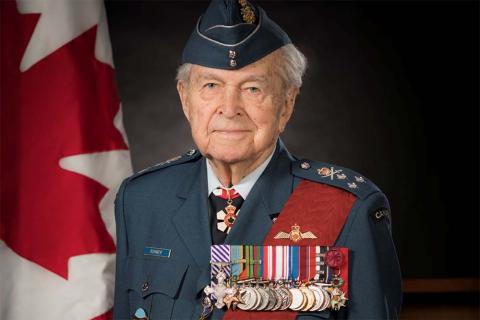
When asked why he joined he simply said, “There was a war on and I wanted to be a part of it.” From 1942-1945, he served with the Royal Canadian Air Force as a fighter-reconnaissance pilot.
“There was a war on and I wanted to be a part of it.”
During the Second World War he took part in D-Day and the Battle of Normandy. He also served in Belgium, Holland and Germany. He completed 135 combat mission tours of operation by November 1944. In July 1944, he was awarded the Distinguished Flying Cross for his successful and well-known reconnaissance missions. After his many years of postwar service he received the rank of Major-General as Chief of Reserves Army. Following his retirement, he continued as an honourary advisor to the Chief of Defence Staff and remained active in a number of military organizations. Today, he holds the title, Honorary Lieutenant General of the Canadian Armed Forces.
During his years in service he became an accomplished lawyer and writer. Over the decades Lieutenant General Rohmer has held many prestigious positions and titles. He is an Officer of the Order of Canada, a Commander of the Order of Military Merit, and served as the Chief of Reserves of the Canadian Armed Forces from 1978-1981. He is a holder of the Jubilee Medal, the Centennial Medal, the Confederation Medal, the Golden Jubilee Medal, the Diamond Jubilee Medal and the Canada Defence medal. Along with Canadian recognition, he has also been appointed by H.M. King Baudoin of Belgium to an Officer in the Order of Leopold in 1989, and in 2004, he was appointed to a Chevalier of the Legion of Honour by the President of France.
“It’s always important to recognize any significant dates in the major battles during World War Two.” Lieutenant General Rohmer has been involved with D-Day and the Battle of Normandy commemoration events for the past 50 years—including working on the Advisory Committee to Veterans Affairs for the 60th and acting as an Advisor to the Minister of Veterans Affairs for the 70th anniversary of D-Day and the Battle of Normandy.
“I’m 95 and still flying and doing all kinds of things, but I know that I can’t last much longer. It’s just the way the world works, so I’m doing the best I can to keep up.”
Lieutenant General Rohmer is passionate about the significance of the 75th anniversary— “The people in D-Day and the Battle of Normandy are diminishing very rapidly in the numbers because we are all getting very old. This will be the last one. It is something that is the end because we are running out of years. I’m 95 and still flying and doing all kinds of things, but I know that I can’t last much longerl. It’s just the way the world works, so I’m doing the best I can to keep up.”
Lieutenant General Richard Rohmer will attend for the 75th commemoration event on Juno Beach in France this year and at international events in Portsmouth, United Kingdom. As the Senior Canadian Veteran of D-Day, he will speak to the assembly at the Juno Beach Centre on behalf of all Canadian D-Day Veterans—as he has at those events since 2004.